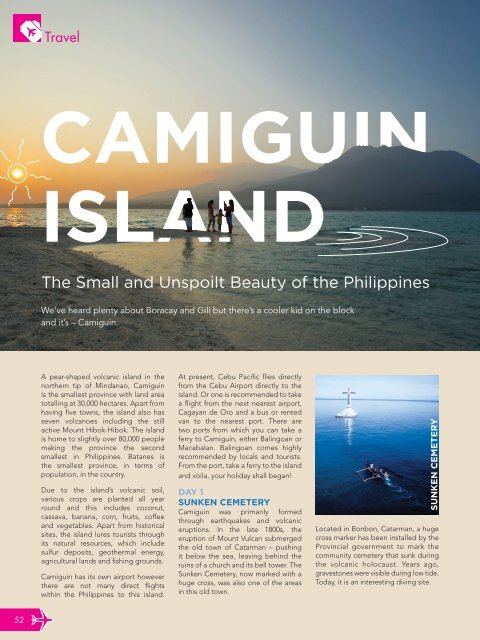CONVERGENCE NOVEMBER - DECEMBER 2016
Create successful ePaper yourself
Turn your PDF publications into a flip-book with our unique Google optimized e-Paper software.
Travel<br />
CAMIGUIN<br />
ISLAND<br />
The Small and Unspoilt Beauty of the Philippines<br />
We've heard plenty about Boracay and Gili but there’s a cooler kid on the block<br />
and it’s – Camiguin.<br />
A pear-shaped volcanic island in the<br />
northern tip of Mindanao, Camiguin<br />
is the smallest province with land area<br />
totalling at 30,000 hectares. Apart from<br />
having five towns, the island also has<br />
seven volcanoes including the still<br />
active Mount Hibok-Hibok. The island<br />
is home to slightly over 80,000 people<br />
making the province the second<br />
smallest in Philippines. Batanes is<br />
the smallest province, in terms of<br />
population, in the country.<br />
Due to the island’s volcanic soil,<br />
various crops are planted all year<br />
round and this includes coconut,<br />
cassava, banana, corn, fruits, coffee<br />
and vegetables. Apart from historical<br />
sites, the island lures tourists through<br />
its natural resources, which include<br />
sulfur deposits, geothermal energy,<br />
agricultural lands and fishing grounds.<br />
Camiguin has its own airport however<br />
there are not many direct flights<br />
within the Philippines to this island.<br />
At present, Cebu Pacific flies directly<br />
from the Cebu Airport directly to the<br />
island. Or one is recommended to take<br />
a flight from the next nearest airport,<br />
Cagayan de Oro and a bus or rented<br />
van to the nearest port. There are<br />
two ports from which you can take a<br />
ferry to Camiguin, either Balingoan or<br />
Macabalan. Balingoan comes highly<br />
recommended by locals and tourists.<br />
From the port, take a ferry to the island<br />
and voila, your holiday shall began!<br />
DAY 1<br />
SUNKEN CEMETERY<br />
Camiguin was primarily formed<br />
through earthquakes and volcanic<br />
eruptions. In the late 1800s, the<br />
eruption of Mount Vulcan submerged<br />
the old town of Catarman – pushing<br />
it below the sea, leaving behind the<br />
ruins of a church and its bell tower. The<br />
Sunken Cemetery, now marked with a<br />
huge cross, was also one of the areas<br />
in this old town.<br />
SUNKEN CEMETERY<br />
Located in Bonbon, Catarman, a huge<br />
cross marker has been installed by the<br />
Provincial government to mark the<br />
community cemetery that sunk during<br />
the volcanic holocaust. Years ago,<br />
gravestones were visible during low tide.<br />
Today, it is an interesting diving site.<br />
52

















